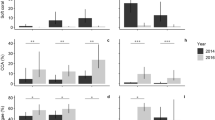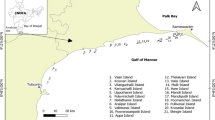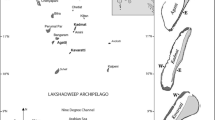Abstract
Climate-induced mass bleaching events are one of the greatest threats to coral reefs, causing widespread loss of coral cover. Drivers of recovery and adaptation for coral reefs in the face of repeated large-scale disturbances are unclear, with marked differences across geographies. Using a monitoring dataset lasting from 2005 to 2018, we documented the response of coral reefs of northwest Mahé in the granitic Seychelles islands following the 1998 and 2016 mass bleaching events. We analysed trends in coral cover, coral community composition and key fish trophic group densities for 24 sites. Coral cover increased almost fourfold from 2005 to 2015 with 42.1% mean coral cover in 2015, highlighting a recovery from the 1998 bleaching event dominated by Acropora growth forms. Impacts of the 2016 bleaching event were less acute than the 1998 one. However, following the 2016 bleaching event, coral cover significantly decreased to 16.1% mean cover in 2017, marked by a sharp decrease of Acropora corals and branching growth forms. Corallivorous, herbivorous and piscivorous fish densities were positively correlated with coral cover from 2005 to 2016. These findings highlight the dominant role of Acropora in recovery from mass coral bleaching events. It also shows the importance of time-series datasets in understanding coral recovery dynamics and their use in an integrated management approach to building reef resilience.








Similar content being viewed by others
Data availability
The data that support the findings of this study are available from the corresponding author upon reasonable request. Christophe Mason-Parker c_mason_parker@hotmail.com.
References
NASA OBPG (2020) MODIS aqua global level 3 mapped SST. Ver. 2019.0. PO.DAAC, CA, USA. https://doi.org/10.5067/MODSA-MO4D9. Accessed --17-July-2021
Bates AE, Cooke RSC, Duncan MI, Edgar GJ, Bruno JF, Benedetti-Cecchi L, Côté IM, Lefcheck JS, Costello MJ, Barrett N, Bird TJ, Fenberg PB, Stuart-Smith RD (2019) Climate resilience in marine protected areas and the ‘Protection Paradox.’ Biol Conserv 236:305–314. https://doi.org/10.1016/j.biocon.2019.05.005
Bellwood DR, Hoey AS, Ackerman JL, Depczynski M (2006) Coral bleaching, reef fish community phase shifts and the resilience of coral reefs. Glob Change Biol 12:1587–1594. https://doi.org/10.1111/j.1365-2486.2006.01204.x
Bindoff NL, Cheung WWL, Kairo JG, Aristegui J, Guinder VA, Hallberg R, Hilmi N, Jiao N, Karim MS, Levin L, O’Donoghue S, Purca Cuicapusa SR, Rinkevich B, Suga T, Tagliabue A, Williamson P (2019) Changing Ocean, Marine Ecosystems, and Dependent Communities. In: Pörtner H-O, Roberts DC, Masson-Delmotte V, Zhai P, Tignor M, Poloczanska E, Mintenbeck K, Alegría A, Nicolai M, Okem A, Petzold J, Rama B, Weyer NM (Eds) IPCC special report on the ocean and cryosphere in a changing climate. In press.
Chong-Seng KM, Graham NAJ, Pratchett MS (2014) Bottlenecks to coral recovery in the Seychelles. Coral Reefs 33:449–461. https://doi.org/10.1007/s00338-014-1137-2
Darling ES, McClanahan TR, Côté IM (2013) Life histories predict coral community disassembly under multiple stressors. Glob Change Biol 19:1930–1940. https://doi.org/10.1111/gcb.12191
Darling ES, Graham NAJ, Januchowski-Hartley FA, Nash KL, Pratchett MS, Wilson SK (2017) Relationships between structural complexity, coral traits, and reef fish assemblages. Coral Reefs 36:561–575. https://doi.org/10.1007/s00338-017-1539-z
Diaz-Pulido G, McCook LJ, Dove S, Berkelmans R, Roff G, Kline DI, Weeks S, Evans RD, Williamson DH, Hoegh-Guldberg O (2009) Doom and boom on a resilient reef: climate change, algal overgrowth and coral recovery. PLoS ONE 4:e5239. https://doi.org/10.1371/journal.pone.0005239
Edmunds PJ, Adam TC, Baker AC, Doo SS, Glynn PW, Manzello DP, Silbiger NJ, Smith TB, Fong P (2019) Why more comparative approaches are required in time-series analyses of coral reef ecosystems. Mar Ecol Prog Ser 608:297–306. https://doi.org/10.3354/meps12805
Engelhardt U (2004) The status of scleractinian coral and reef-associated fish communities 6 years after the 1998 mass coral bleaching event. Seychelles Marine Ecosystem Management Project (SEYMEMP)—final report. Reefcare International, Townsville
English S, Wilkinson C, Baker V (1997) Survey manual for tropical marine resources. Australian Institute of Marine Science, Townsville
Froese R, Pauly D (2019) FishBase. world wide web electronic publication. http://www.fishbase.org. Last accessed 13 Jan 2019
Gardner TA, Côté IM, Gill JA, Grant A, Watkinson AR (2003) Long-term region-wide declines in Caribbean corals. Science 301:958–960. https://doi.org/10.1126/science.1086050
Gilmour JP, Smith LD, Heyward AJ, Baird AH, Pratchett MS (2013) Recovery of an isolated coral reef system following severe disturbance. Science 340:69–71. https://doi.org/10.1126/science.1232310
Golbuu Y, Victor S, Penland L, Idip D, Emaurois C, Okaji K, Yukihira H, Iwase A, van Woesik R (2007) Palau’s coral reefs show differential habitat recovery following the 1998-bleaching event. Coral Reefs 26:319–332. https://doi.org/10.1007/s00338-007-0200-7
Graham NAJ, Wilson SK, Jennings S, Polunin NVC, Bijoux JP, Robinson J (2006) Dynamic fragility of oceanic coral reef ecosystems. Proc Natl Acad Sci 103:8425–8429. https://doi.org/10.1073/pnas.0600693103
Graham NAJ, Wilson SK, Jennings S, Polunin NVC, Robinson J, Bijoux JP, Daw TM (2007) Lag effects in the impacts of mass coral bleaching on coral reef fish, fisheries, and ecosystems. Conserv Biol J Soc Conserv Biol 21:1291–1300. https://doi.org/10.1111/j.1523-1739.2007.00754.x
Graham NAJ, McClanahan TR, MacNeil MA, Wilson SK, Polunin NVC, Jennings S, Chabanet P, Clark S, Spalding MD, Letourneur Y, Bigot L, Galzin R, Öhman MC, Garpe KC, Edwards AJ, Sheppard CRC (2008) Climate warming, marine protected areas and the ocean-scale integrity of coral reef ecosystems. PLoS ONE 3:e3039. https://doi.org/10.1371/journal.pone.0003039
Graham NAJ, Jennings S, MacNeil MA, Mouillot D, Wilson SK (2015) Predicting climate-driven regime shifts versus rebound potential in coral reefs. Nature 518:94–97. https://doi.org/10.1038/nature14140
Graham NAJ, Robinson JPW, Smith SE, Govinden R, Gendron G, Wilson SK (2020) Changing role of coral reef marine reserves in a warming climate. Nat Commun 11:1–8. https://doi.org/10.1038/s41467-020-15863-z
Guest JR, Tun K, Low J, Vergés A, Marzinelli EM, Campbell AH, Bauman AG, Feary DA, Chou LM, Steinberg PD (2016) 27 years of benthic and coral community dynamics on turbid, highly urbanised reefs off Singapore. Nat Sci Rep 6:36260
Harris A, Wilson S, Graham N, Sheppard C (2014) Scleractinian coral communities of the inner Seychelles 10 years after the 1998 mortality event. Aquat Conserv Mar Freshw Ecosyst 24:667–679. https://doi.org/10.1002/aqc.2464
Hedges LV, Gurevitch J, Curtis PS (1999) The meta-analysis of response ratios in experimental ecology. Ecology 80:1150–1156. https://doi.org/10.2307/177062
Hodgson D, McDonald JL, Hosken DJ (2015) What do you mean, “resilient”? Trends Ecol Evol 30:503–506. https://doi.org/10.1016/j.tree.2015.06.010
Hoegh-Guldberg O, Mumby PJ, Hooten AJ, Steneck RS, Greenfield P, Gomez E, Harvell CD, Sale PF, Edwards AJ, Caldeira K, Knowlton N, Eakin CM, Iglesias-Prieto R, Muthiga N, Bradbury RH, Dubi A, Hatziolos ME (2007) Coral reefs under rapid climate change and ocean acidification. Science 318:1737–1742. https://doi.org/10.1126/science.1152509
Holbrook SJ, Schmitt RJ, Brooks AJ (2008) Resistance and resilience of a coral reef fish community to changes in coral cover. Mar Ecol Prog Ser 371:263–271. https://doi.org/10.3354/meps07690
Holbrook SJ, Adam TC, Edmunds PJ, Schmitt RJ, Carpenter RC, Brooks AJ, Lenihan HS, Briggs CJ (2018) Recruitment drives spatial variation in recovery rates of resilient coral reefs. Sci Rep 8:1–11. https://doi.org/10.1038/s41598-018-25414-8
Hughes TP, Graham NAJ, Jackson JBC, Mumby PJ, Steneck RS (2010) Rising to the challenge of sustaining coral reef resilience. Trends Ecol Evol 25:633–642. https://doi.org/10.1016/j.tree.2010.07.011
Hughes TP, Anderson KD, Connolly SR, Heron SF, Kerry JT, Lough JM, Baird AH, Baum JK, Berumen ML, Bridge TC, Claar DC, Eakin CM, Gilmour JP, Graham NAJ, Harrison H, Hobbs J-PA, Hoey AS, Hoogenboom M, Lowe RJ, McCulloch MT, Pandolfi JM, Pratchett M, Schoepf V, Torda G, Wilson SK (2018) Spatial and temporal patterns of mass bleaching of corals in the Anthropocene. Science 359:80–83. https://doi.org/10.1126/science.aan8048
Karger DN, Conrad O, Böhner J, Kawohl T, Kreft H, Soria-Auza RW, Zimmermann NE, Linder HP, Kessler M (2017) Data from: Climatologies at high resolution for the earth’s land surface areas. Dryad Digital Repos. https://doi.org/10.5061/dryad.kd1d4
Kassambara A (2020) ggpubr: ‘ggplot2’ based publication ready plots. R package version 0.4.0. https://cran.r-project.org/web/packages/ggpubr/index.html
Kayal M, Lenihan HS, Brooks AJ, Holbrook SJ, Schmitt RJ, Kendall BE (2018) Predicting coral community recovery using multi-species population dynamics models. Ecol Lett 21:1790–1799. https://doi.org/10.1111/ele.13153
Magel JMT, Burns JHR, Gates RD, Baum JK (2019) Effects of bleaching-associated mass coral mortality on reef structural complexity across a gradient of local disturbance. Sci Rep 9:2512. https://doi.org/10.1038/s41598-018-37713-1
Maynard JA, McKagan S, Raymundo L, Johnson S, Ahmadia GN, Johnston L, Houk P, Williams GJ, Kendall M, Heron SF, van Hooidonk R, Mcleod E, Tracey D, Planes S (2015) Assessing relative resilience potential of coral reefs to inform management. Biol Conserv 192:109–119. https://doi.org/10.1016/j.biocon.2015.09.001
McClanahan TR (2008) Response of the coral reef benthos and herbivory to fishery closure management and the 1998 ENSO disturbance. Oecologia 155:169–177. https://doi.org/10.1007/s00442-007-0890-0
Mellin C, MacNeil MA, Cheal AJ, Emslie MJ, Caley MJ (2016) Marine protected areas increase resilience among coral reef communities. Ecol Lett 19:629–637. https://doi.org/10.1111/ele.12598
Moustafa MZ, Moustafa MS, Moustafa ZD, Moustafa SE (2014) Survival of high latitude fringing corals in extreme temperatures: Red Sea oceanography. J Sea Res 88:144–151. https://doi.org/10.1016/j.seares.2014.01.012
Mumby PJ, Dahlgren CP, Harborne AR, Kappel CV, Micheli F, Brumbaugh DR, Holmes KE, Mendes JM, Broad K, Sanchirico JN, Buch K, Box S, Stoffle RW, Gill AB (2006) Fishing, trophic cascades, and the process of grazing on coral reefs. Science 311:98–101. https://doi.org/10.1126/science.1121129
Obura D, Gudka M, Abdou Rabi F, Gian SB, Bijoux JP, Freed S, Maharavo J, Mwaura J, Porter S, Sola E, Wickel J, Yahya S, Ahamada S (2017) Coral reef status report of the western Indian Ocean. Global coral reef monitoring network (GCRMN)/International Coral Reef Initiative (ICRI)
Oksanen J, Blanchet FG, Friendly M, Kindt R, Legendre P, McGlinn D, Minchin P, O’Hara RB, Simpson G, Solymos P, Stevens MHH, Szöcs E, Wagner H (2020) vegan community ecology package version 2. 5–7 November 2020. https://www.researchgate.net/publication/346579465_vegan_community_ecology_package_version_25-7_November_2020/citation/download
Osborne K, Dolman AM, Burgess SC, Johns KA (2011) Disturbance and the dynamics of coral cover on the great barrier reef (1995–2009). PLoS ONE. https://doi.org/10.1371/journal.pone.0017516
Pratchett MS, Munday PL, Wilson SK, Graham NAJ, Cinner JE, Bellwood DR, Jones GP, Polunin NVC, McClanahan TR (2008) Effects of climate-induced coral bleaching on coral-reef fishes—ecological and economic consequences. Oceanogr Mar Biol Annu Rev 46:251–296
Pratchett MS, Hoey AS, Wilson SK, Messmer V, Graham NAJ (2011) Changes in biodiversity and functioning of reef fish assemblages following coral bleaching and coral loss. Diversity 3:424–452. https://doi.org/10.3390/d3030424
Pratchett MS, Hoey AS, Wilson SK (2014) Reef degradation and the loss of critical ecosystem goods and services provided by coral reef fishes. Curr Opin Environ Sustain 7:37–43. https://doi.org/10.1016/j.cosust.2013.11.022
R Core Team (2021) R: a language and environment for statistical computing. R Foundation for Statistical Computing, Vienna
Samoilys M, Roche R, Koldewey H, Turner J (2018) Patterns in reef fish assemblages: insights from the chagos archipelago. PLoS ONE 13:e0191448. https://doi.org/10.1371/journal.pone.0191448
Samoilys MA, Halford A, Osuka K (2019) Disentangling drivers of the abundance of coral reef fishes in the western Indian Ocean. Ecol Evol 9:4149–4167. https://doi.org/10.1002/ece3.5044
Selig ER, Bruno JF (2010) A global analysis of the effectiveness of marine protected areas in preventing coral loss. PLoS ONE 5:e9278. https://doi.org/10.1371/journal.pone.0009278
Spalding MD, Jarvis GE (2002) The impact of the 1998 coral mortality on reef fish communities in the Seychelles. Mar Pollut Bull 44:309–321. https://doi.org/10.1016/S0025-326X(01)00281-8
Spencer T, Teleki KA, Bradshaw C, Spalding MD (2000) Coral bleaching in the southern Seychelles during the 1997–1998 Indian Ocean warm event. Mar Pollut Bull 40:569–586. https://doi.org/10.1016/S0025-326X(00)00026-6
Sully S, Burkepile DE, Donovan MK, Hodgson G, van Woesik R (2019) A global analysis of coral bleaching over the past two decades. Nat Commun 10:1–5. https://doi.org/10.1038/s41467-019-09238-2
Torda G, Sambrook K, Cross P, Sato Y, Bourne DG, Lukoschek V, Hill T, Torras Jorda G, Moya A, Willis BL (2018) Decadal erosion of coral assemblages by multiple disturbances in the Palm Islands, central great barrier reef. Sci Rep 1:11885. https://doi.org/10.1038/s41598-018-29608-y
Turner J, Klaus R, Engelhardt U (2000) The reefs of the granitic islands of the Seychelles. In: Souter D, Obura D, Linden O (Eds) Coral reef degradation in the Indian Ocean. CORDIO/SAREC, pp 77–86
van Hooidonk R, Maynard J, Tamelander J, Gove J, Ahmadia G, Raymundo L, Williams G, Heron SF, Planes S (2016) Local-scale projections of coral reef futures and implications of the Paris agreement. Nat Sci Rep 6:39666. https://doi.org/10.1038/srep39666
van Rij J, Wieling M, Baayen R, van Rijn H (2020) itsadug: interpreting time series and autocorrelated data using GAMMs. R package version 2.4. https://cran.r-project.org/web/packages/itsadug/citation.html
Viviani J, Moritz C, Parravicini V, Lecchini D, Siu G, Galzin R, Viriot L (2019) Synchrony patterns reveal different degrees of trophic guild vulnerability after disturbances in a coral reef fish community. Divers Distrib 25:1210–1221. https://doi.org/10.1111/ddi.12931
Wickham H (2016) ggplot2: elegant graphics for data analysis. Springer-Verlag, New York
Wilson SK, Robinson JPW, Chong-Seng K, Robinson J, Graham NAJ (2019) Boom and bust of keystone structure on coral reefs. Coral Reefs. https://doi.org/10.1007/s00338-019-01818-4
Wood SN (2011) Fast stable restricted maximum likelihood and marginal likelihood estimation of semiparametric generalized linear models. J R Stat Soc Series B Stat Methodol 73(1):3–36
Wood SN (2017) Generalized additive models: an introduction with R, 2nd edn. Chapman and Hall/CRC, Boca Raton
Zinke J, Gilmour JP, Fisher R, Puotinen M, Maina J, Darling E, Stat M, Richards ZT, Mcclanahan TR, Beger M, Moore C, Graham NAJ, Feng M, Hobbs J-PA, Evans SN, Field S, Shedrawi G, Babcock RC, Wilson SK (2018) Gradients of disturbance and environmental conditions shape coral community structure for south-eastern Indian Ocean reefs. Divers Distrib 24:605–620. https://doi.org/10.1111/ddi.12714
Zupan M, Fragkopoulou E, Claudet J, Erzini K, Costa BHE, Gonçalves EJ (2018) Marine partially protected areas: drivers of ecological effectiveness. Front Ecol Environ 16:381–387. https://doi.org/10.1002/fee.1934
Acknowledgements
We would like to thank all the previous staff and volunteers of Global Vision International Seychelles who helped with data collection, together with the Seychelles National Parks Authority for their invaluable logistical support. We also thank Isabella Mandl and Paula Silvar for helping with the statistical analysis.
Author information
Authors and Affiliations
Contributions
FV, JB, GG and CM-P contributed to the study conception and design. Material preparation and data collection were carried out by FV and CM-P. Data analysis was performed by FV, CJM, JB, GG and CM-P. The first draft of the manuscript was written by FV and all the authors commented on previous versions of the manuscript. All the authors read and approved the final manuscript.
Corresponding author
Ethics declarations
Conflict of interest
No funding was received to assist with the preparation of this manuscript and the authors declare that they have no competing interests.
Additional information
Responsible Editor: S. Harii.
Publisher's Note
Springer Nature remains neutral with regard to jurisdictional claims in published maps and institutional affiliations.
Supplementary Information
Below is the link to the electronic supplementary material.
Rights and permissions
About this article
Cite this article
Vessaz, F., Marsh, C.J., Bijoux, J. et al. Recovery trajectories of oceanic reef ecosystems following multiple mass coral bleaching events. Mar Biol 169, 23 (2022). https://doi.org/10.1007/s00227-021-04013-8
Received:
Accepted:
Published:
DOI: https://doi.org/10.1007/s00227-021-04013-8




